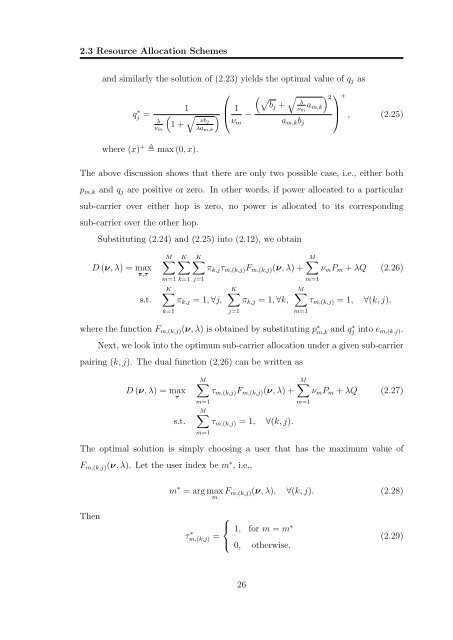Resource Allocation in OFDM Based Wireless Relay Networks ...
Resource Allocation in OFDM Based Wireless Relay Networks ...
Resource Allocation in OFDM Based Wireless Relay Networks ...
You also want an ePaper? Increase the reach of your titles
YUMPU automatically turns print PDFs into web optimized ePapers that Google loves.
2.3 <strong>Resource</strong> <strong>Allocation</strong> Schemes<br />
and similarly the solution of (2.23) yields the optimal value of q j as<br />
q ∗ j =<br />
λ<br />
ν m<br />
(1 +<br />
where (x) + max (0, x).<br />
1<br />
√ )<br />
νbj<br />
λa m,k<br />
⎛<br />
⎜<br />
⎝ 1 −<br />
ν m<br />
( √bj<br />
+<br />
√<br />
a m,k b j<br />
) 2<br />
λ<br />
ν m<br />
a m,k<br />
⎞<br />
⎟<br />
⎠<br />
+<br />
, (2.25)<br />
The above discussion shows that there are only two possible case, i.e., either both<br />
p m,k and q j are positive or zero. In other words, if power allocated to a particular<br />
sub-carrier over either hop is zero, no power is allocated to its correspond<strong>in</strong>g<br />
sub-carrier over the other hop.<br />
Substitut<strong>in</strong>g (2.24) and (2.25) <strong>in</strong>to (2.12), we obta<strong>in</strong><br />
D (ν, λ) = max<br />
π,τ<br />
s.t.<br />
M∑ K∑ K∑<br />
M∑<br />
π k,j τ m,(k,j) F m,(k,j) (ν, λ) + ν m P m + λQ (2.26)<br />
m=1 k=1 j=1<br />
K∑<br />
π k,j = 1, ∀j,<br />
k=1<br />
j=1<br />
m=1<br />
m=1<br />
K∑<br />
M∑<br />
π k,j = 1, ∀k, τ m,(k,j) = 1, ∀(k, j),<br />
where the function F m,(k,j) (ν, λ) is obta<strong>in</strong>ed by substitut<strong>in</strong>g p ∗ m,k and q∗ j <strong>in</strong>to e m,(k,j) .<br />
Next, we look <strong>in</strong>to the optimum sub-carrier allocation under a given sub-carrier<br />
pair<strong>in</strong>g (k, j). The dual function (2.26) can be written as<br />
D (ν, λ) = max<br />
τ<br />
s.t.<br />
M∑<br />
M∑<br />
τ m,(k,j) F m,(k,j) (ν, λ) + ν m P m + λQ (2.27)<br />
m=1<br />
M∑<br />
τ m,(k,j) = 1,<br />
m=1<br />
∀(k, j).<br />
m=1<br />
The optimal solution is simply choos<strong>in</strong>g a user that has the maximum value of<br />
F m,(k,j) (ν, λ). Let the user <strong>in</strong>dex be m ∗ , i.e.,<br />
m ∗ = arg max<br />
m F m,(k,j)(ν, λ), ∀(k, j). (2.28)<br />
Then<br />
⎧<br />
⎨ 1, for m = m ∗<br />
τm,(k,j) ∗ =<br />
⎩ 0, otherwise.<br />
(2.29)<br />
26

















